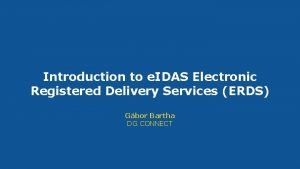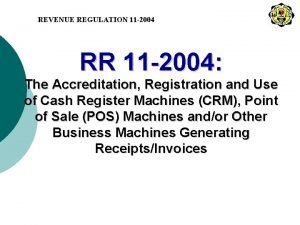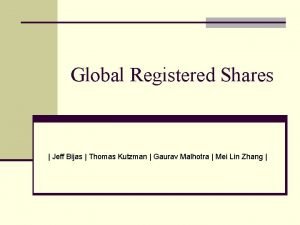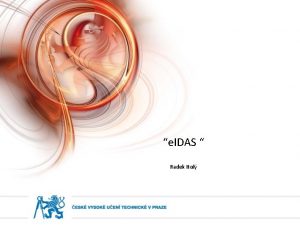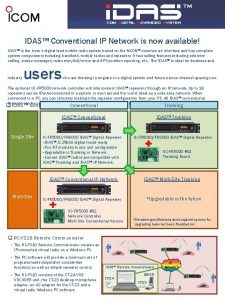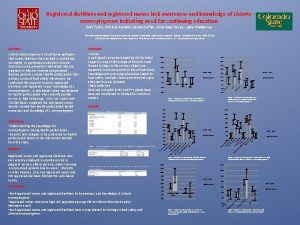Introduction to e IDAS Electronic Registered Delivery Services



















- Slides: 19

Introduction to e. IDAS Electronic Registered Delivery Services (ERDS) Gábor Bartha DG CONNECT

e. IDAS = Toolbox e. ID Website authentication E-registered delivery Preservation E-signature E-seals Time stamp

E-Transactions workflow Website authentication E-registered delivery Filing a claim with a court e. ID Creation of the claim Time stamp E-signature E-seals Preservation 3

The e. IDAS Legal Framework Legal Act Reference e. IDAS Regulation 910/2014 ID on procedural arrangements for MS cooperation on e. ID (art. 12. 7) e. ID Trust services 2015/296 Adoption date 23. 07. 2014 24. 02. 2015 Entry into force 17. 09. 2014 (1. 07. 2016 - application provisions on TS) 17. 03. 2015 IR on interoperability framework (art. 12. 8) Corrigendum C(2015) 8550 of 4. 02. 2016 2015/1501 8. 09. 2015 29. 09. 2015 IR assurance levels for electronic identification means (art. 8. 3) 2015/1502 8. 09. 2015 29. 09. 2015 ID on circumstances, formats and procedures of notification (art. 9. 5) 2015/1984 3. 11. 2015 5. 11. 2015 (notified to Ms) IR on EU Trust Mark for Qualified Trust Services (art. 23. 3) 2015/806 22. 05. 2015 12. 06. 2015 ID on technical specifications and formats relating to trusted lists (art. 22. 5) 2015/1505 8. 09. 2015 29. 09. 2015 ID on formats of advanced electronic signatures and seals (art. 27. 5 & 37. 5) 2015/1506 8. 09. 2015 29. 09. 2015 ID on standards for the security assessment of qualified signature and seal creation devices (art. 30. 3 & 39. 2) 2016/2303 25. 04. 2016 05. 2016

e. IDAS – The Regulation in a nutshell 2 MAIN CHAPTERS SUBJECT TO DIFFERENT RULES AND REQUIREMENTS Chapter III Mutual recognition of e-identification means Electronic trust services • • • Chapter IV Electronic Documents Electronic signatures Electronic seals Time stamping Electronic registered delivery service Website authentication

e. IDAS: Key principles for e. ID The Regulation does not impose the use of e. ID Cooperation between Member States Sovereignty of MS to use or introduce means for e. ID Interoperability framework Principle of reciprocity relying on defined levels of assurance Mandatory crossborder recognition only to access public services Full autonomy for private sector

e. IDAS: Key principles for Trust services The Regulation does not impose the use of Trust services Transparency and accountability Technological neutrality Non-mandatory technical standards ensuring presumption of compliance Specific legal effects associated to qualified trust services Non-discrimination in Courts of e. TS vs paper equivalent Risk management approach

e. IDAS e. ID Electronic signatures Electronic seals Electronic time stamps Electronic registered delivery services Website authentication Electronic documents Validation Preservation e. IDAS

Definition of Trust Services & electronic documents art. 3(36) (art. 2(9) of Directive 97/67) Electronic registered delivery service Registered item 'electronic registered delivery service' means a service that makes it possible to transmit data between third parties by electronic means and provides evidence relating to the handling of the transmitted data, including proof of sending and receiving the data, and which protects transmitted data against the risk of loss, theft, damage or any unauthorised alterations 'registered item' means a service providing a flat-rate guarantee against risks of loss, theft or damage and supplying the sender, where appropriate upon request, with proof of the handing in of the postal item and/or of its delivery to the addressee

e. IDAS – Trust services Horizontal principles Liability International aspects Trusted lists Electronic signatures, including validation and preservation services Supervision Qualified services Electronic seals, including validation and preservation services Security requirements Prior authorisation Time stamping Data protection EU trust mark Electronic registered delivery service Website authentication

Key principles for e-registered delivery services Market oriented Technological neutrality Accountability Legal certainty

Non-qualified electronic registered delivery service providers (1) Obligations of non-qualified electronic registered delivery service providers • Verify that requirements of the Regulation applicable to (all) TSPs are met: • Data processing and protection (art. 5) • Liability and burden of proof, including limitation of use of the services (art. 13) • Access to person with disabilities (art. 15) • Risk management and security breach notification (art. 19) Associated legal effect to the service • Non-discrimination as evidence in court vis-à-vis paper equivalent

Non-qualified electronic registered delivery service providers (2) Obligations of non-qualified electronic registered delivery service providers • The supervisory body has no general obligation to supervise non-qualified service providers. • The supervisory body should only take action when it is informed (for example, by the nonqualified trust service provider itself, by another supervisory body, by a notification from a user or a business partner or on the basis of its own investigation) that a non-qualified trust service provider does not comply with the requirements of this Regulation. (Recital 36) Sanctions if non-compliance of is established? • Member States shall lay down the rules on penalties applicable to infringements of this Regulation. The penalties provided for shall be effective, proportionate and dissuasive. (art. 16)

Qualified electronic registered delivery service (1) Obligations of qualified e-registered delivery service providers • Fulfil Initiation procedure • Meet all requirements applicable to all TSPs (art. 5, 13, 15 and 19) • Meet Requirements for all QTSPs (art. 24. 2) • • • Employ competent staff Financial resources to cover liability risks Anti-forgery measures Use trustworthy systems Termination plans …. • The electronic registered delivery service the TSP intend to provide shall meet the requirements for qualified electronic registered delivery services (art. 44)

Qualified electronic registered delivery service (2) E-registered delivery : requirements to be qualified • Provided by one or more qualified trust service provider(s); • Ensure with a high level of confidence the identification of the sender; • Ensure the identification of the addressee before the delivery of the data; • Sending and receiving of data is secured by an advanced electronic signature or an advanced electronic seal to preclude the possibility of the data being changed undetectably; • any change of the data needed for the purpose of sending or receiving the data is clearly indicated to the sender and addressee of the data; • the date and time of sending, receiving and any change of data are indicated by a qualified electronic time stamp. All TSPs involved in the transmission of data shall be qualified > Interoperability is key > Cef e. Delivery Acces Point (e. Sens profile of AS 4 tech. spec. )

Qualified electronic registered delivery service (3) Supervision /control • Before starting providing a qualified e-registered delivery service: Procedure of initiation (art. 21) • Notification of the intend to start providing e-registered delivery service together with a conformity assessment report • SB verifies that a TSP and TS meets the requirements of the Regulation within 3 months • Grants the qualified status (or refuses) • Inform the body in charge of the Trusted List to add it to the list • While providing the qualified e-registered delivery service on an ad hoc basis (art. 20. 2) • Every 2 years from the granting of the qualified status to the QTSP and the qualified e-registered delivery service (art. 20. 1) Sanctions if non-compliance of QTSP is established? • Where a QTSP does not remedy to an identified failure: withdraw the qualified status of that provider or of the affected service it provides (art. 20. 3). • Member States shall lay down the rules on penalties applicable to infringements of this Regulation. The penalties provided for shall be effective, proportionate and dissuasive. (art. 16)

Qualified electronic registered delivery service (4) Associated legal effect to the qualified e-registered delivery service • Non-discrimination as evidence in court vis-à-vis paper equivalent • Data sent and received enjoy the presumption of: • the integrity of the data, • the sending of that data by the identified sender, • the receipt of the data by the identified addressee • the accuracy of the date and time of sending and receipt of the data.

e. IDAS – Supporting tools Trusted lists for QTSPs and QTSs (art. 22 and ID (EU) 2015/1505) • Ensure continuity with the existing TLs established under the Service Directive. • Ensure legal certainty. • Foster interoperability of qualified trust services by facilitating a. o. the validation of e-signatures and e-seals. • Allow citizens, businesses and public administrations to easily get the status of a trust service. EU trust mark for qualified trust services (art. 23 and (EU) 2015/806) • Usage by QTSP after qualified status has been indicated in the TLs • Trustmark indicates in a simple, recognisable, and clear manner the qualified status of a trust service • Link to the relevant TL has to be ensured by the QTSP

Implementing acts Possibility for the Commission to adopt implementing acts to list standards for processes for sending and receiving data: • Their use will not be mandatory • Their use will bring presumption of compliance with the requirements of the Regulation Adoption of this implementing act would take into account considerations related to: Legal certainty Market needs Availability of standards (or Technical specifications) Compatibility of standards (or Technical specifications) with requirements set in the Regulation • Outcomes of non-regulatory approach (such as CEF actions) • •
 Electronic registered delivery service
Electronic registered delivery service An electronic is the electronic exchange of money or scrip
An electronic is the electronic exchange of money or scrip Electronic news gathering and electronic field production
Electronic news gathering and electronic field production Electronic software delivery system
Electronic software delivery system Accenture methodology
Accenture methodology What is a crsp designation
What is a crsp designation Sworn statement for esales registration
Sworn statement for esales registration Registered automotive workshop scheme
Registered automotive workshop scheme Architecture council pakistan
Architecture council pakistan Appointment of registered valuer under companies act, 2013
Appointment of registered valuer under companies act, 2013 Registered provider
Registered provider Registered training organisation list
Registered training organisation list Nhtsa registered importers 2020
Nhtsa registered importers 2020 Global registered shares
Global registered shares Ubc nursing program
Ubc nursing program Registered nurse requirements california
Registered nurse requirements california Problems of trade union
Problems of trade union Lonestar adn
Lonestar adn Rdsp catch up calculator
Rdsp catch up calculator Ordnance factory registration
Ordnance factory registration
